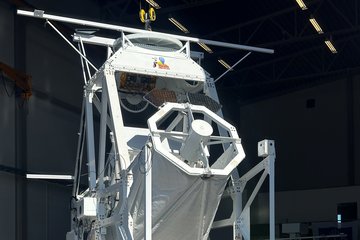All genres
41.
Journal Article
A journey of exploration to the polar regions of a star: probing the solar poles and the heliosphere from high helio-latitude. Experimental Astronomy (2021)
42.
Journal Article
Modelling the evolution of the Sun's open and total magnetic flux. Astronomy and Astrophysics 650, A70 (2021)
43.
Journal Article
On the size distribution of spots within sunspot groups. Astronomy and Astrophysics 652, A9 (2021)
44.
Journal Article
Sunspot Simulations: Penumbra Formation and the Fluting Instability. The Astrophysical Journal 907 (2), 102 (2021)
45.
Journal Article
Vortex flow properties in simulations of solar plage region: Evidence for their role in chromospheric heating. Astronomy and Astrophysics 645, A3 (2021)
46.
Journal Article
Slow magneto-acoustic waves in simulations of a solar plage region carry enough energy to heat the chromosphere. Astronomy and Astrophysics 652, A43 (2021)
47.
Journal Article
Loss of toroidal magnetic flux by emergence of bipolar magnetic regions. Astronomy and Astrophysics 636, A7 (2020)
48.
Journal Article
Rossby modes in slowly rotating stars: depth dependence in distorted polytropes with uniform rotation. Astronomy and Astrophysics 637, A65 (2020)
49.
Journal Article
Meridional flow in the Sun’s convection zone is a single cell in each hemisphere. Science 368 (6498), pp. 1469 - 1472 (2020)
50.
Journal Article
Power spectra of solar brightness variations at various inclinations. Astronomy and Astrophysics 636, A43 (2020)
51.
Journal Article
3D Radiative MHD Simulations of Starspots. The Astrophysical Journal 893 (2), 113 (2020)
52.
Journal Article
The Sun is less active than other solar-like stars. Science 368 (6490), pp. 518 - 521 (2020)
53.
Journal Article
Average motion of emerging solar active region polarities: II. Joy's law. Astronomy and Astrophysics 640, A116 (2020)
54.
Journal Article
Simulations Show that Vortex Flows Could Heat the Chromosphere in Solar Plage. Astrophysical Journal, Letters 894 (2), L17 (2020)
55.
Journal Article
Power spectrum of turbulent convection in the solar photosphere. Astronomy and Astrophysics 644, A44 (2020)
56.
Journal Article
The relationship between flux emergence and subsurface toroidal magnetic flux. Astronomy and Astrophysics; EDP Sciences, Les Ulis Cedex A France 631, A27 (2019)
57.
Journal Article
Solar activity: periodicities beyond 11 years are consistent with random forcing. Astronomy and Astrophysics 625, A28 (2019)
58.
Journal Article
Starspot rotation rates versus activity cycle phase: Butterfly diagrams of Kepler stars are unlike that of the Sun. Astronomy and Astrophysics 622, A85 (2019)
59.
Journal Article
Average motion of emerging solar active region polarities: I. Two phases of emergence. Astronomy and Astrophysics 625, A53 (2019)
60.
Journal Article
Chromospheric activity catalogue of 4454 cool stars: Questioning the active branch of stellar activity cycles. Astronomy and Astrophysics 616, A108 (2018)











